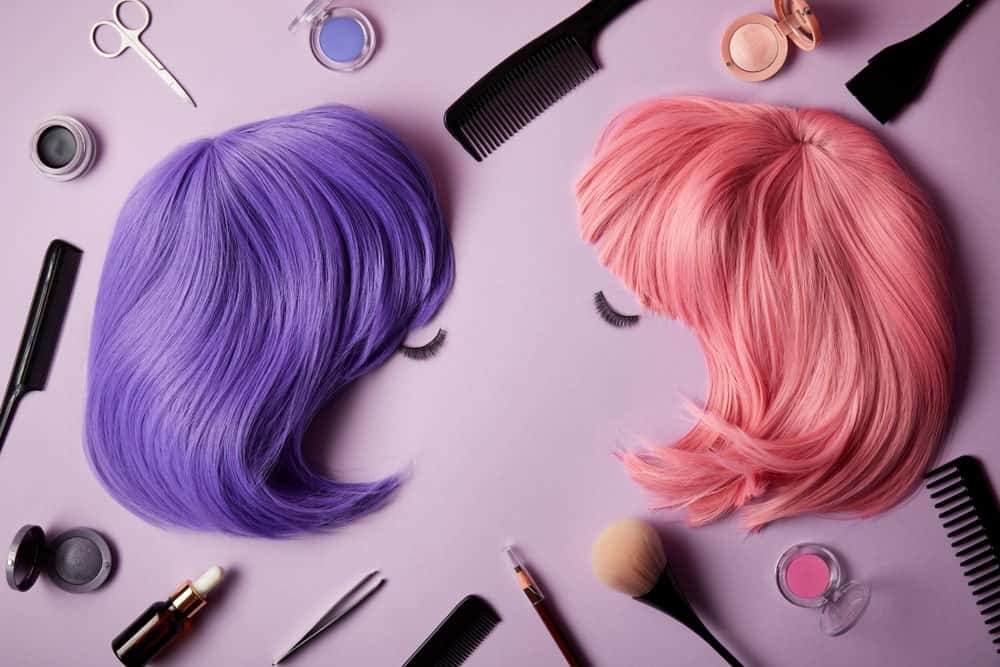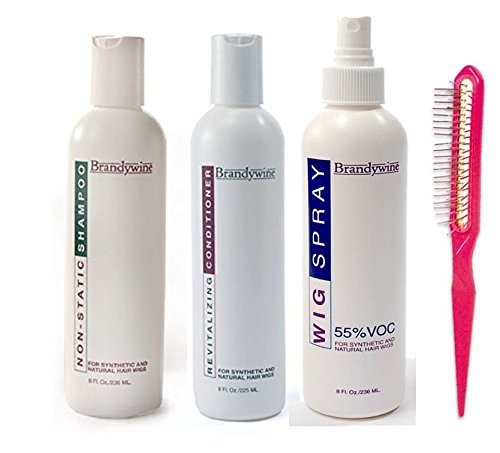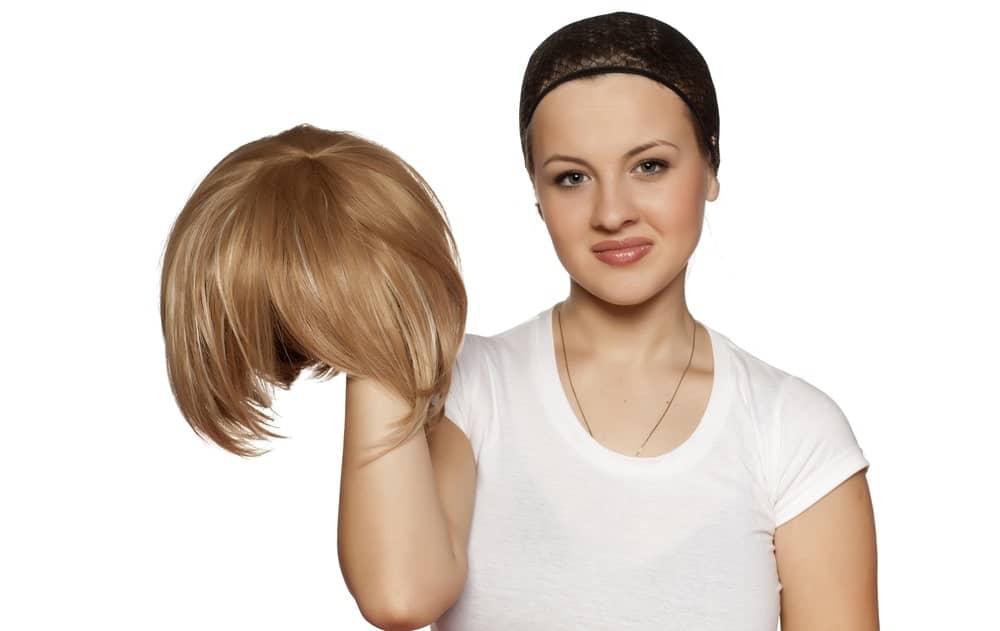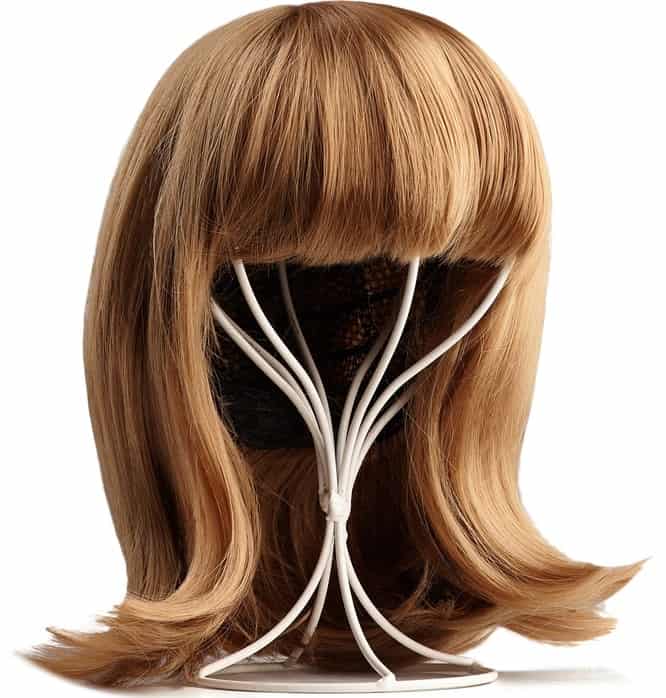After investing in a great wig, it's important to take care of it properly. Check out these must have wig accessories to make sure your wig stays looking great and lasts a long time.

Wigs have been a part of various cultures in the world for more than 1500 years. Their uses have been to enhance holiday or festive apparel, to protect the head from the sun, to choose a different hair color, to fit in with the current fashion trends, and to deal with hair loss.
There are many wigs in museums and their use throughout history always tells an interesting story. Today, wigs are worn in a variety of circumstances and advancements have made them look more real, stay on better, and feel more comfortable. Thanks to wig accessories, wig wearers can feel more confident when wearing a wig and have the tools to keep them looking great.
Contents
- Wig Brushes and Combs
- Shampoo and Conditioner
- Styling Tools
- Adhesives and Tapes
- Wig Caps
- Wig Stands
- Wig Storage
- FAQs
- What are the pros and cons of real and synthetic hair in a wig?
- How do you maintain a wig?
- What type of wig looks most natural?
- How much does a good wig cost?
- How do you choose a wig cap?
- Does wearing a wig ruin your hair?
- How do you keep from sweating when wearing a wig?
- What are the most important wig accessories?
Wig Brushes and Combs
It’s important to know that regular brushes and combs can’t be used on wigs. Regular brushes are too rough and will damage the wig, making it not last as long. There are special combs and brushes made specifically for wigs. These combs and brushes are an essential part of wig care and your wig maintenance routine. They are much gentler on wigs and help them to last a long time.
The Importance of Brushing Your Wig
Both wigs and hair extensions need to be brushed daily to make sure the hair lasts for a long time and continues to look great. This is true of wefts, fusion, beads, tape extensions, or linked extensions. Wigs, a hair extension, and salon investments are expensive and it’s important to take care of them so that they will last.
Wig Brushes

A loop brush has nylon bristles that are looped, meaning that there is no tip at all. With this design, there is nothing that can get snagged or caught in the hair. The wig will be protected and will last longer when using this type of brush.
A loop brush is great for lace front wigs, synthetic wigs, and falls. The loop brush will also work for wigs that are made from synthetic hair, natural human hair, or animal fibers. Men can use this brush too for a toupee or natural men’s hairpiece. To use this brush, simply place the wig on a mannequin and gently brush from the ends to the roots.
Another option for a wig brush is one with metal prongs. Wig brushes made with wire have small pins at the end of the wire to keep the hair from dragging. Wire wig brushes work well with synthetic hair and are a much better choice than plastic bristles.
Wig Combs

Wig combs are made in a wide-toothed design to be extra gentle. They are soft and gentle so that wig hair and caps will not be damaged. Wig combs can be made of plastic or wood. Wood is a popular choice because it does a great job of smoothing the hair and can withstand knots without a risk of breaking. If using wooden tools for wig care, you can even infuse essential oils into them. This can keep the hair smooth and lubricated, just like your scalp would do with natural hair.
Wig Picks

Wig picks are smaller than wig combs, are thicker, and have fewer teeth. These work well for large wigs or those that are thick or very textured. These tools can also help with wig styling such as backcombing, teasing, or just smoothing the hair fibers. Plastic and wood picks are available, but solid wood picks will give the best smoothing effect. Although they are slightly more expensive, the investment for wood is worth it.
Wig clips
Wig clips hold the wig securely to a person’s head. Oftentimes they are permanently sewn in. They can be used with wigs and other hairpieces.
Shampoo and Conditioner

In addition to regular combing or brushing, it’s essential to regularly cleanse your wig. Wigs get dirty and sweaty and need to be cleaned, just don’t overdo it, as washing the wig will limit the lifespan. Every circumstance is a little different, but it is a good idea to wash a synthetic wig every 10 to 15 wearings and a human hair wig every 7 to 10 wearings.
Prepare your wig for washing by combing or brushing out all of the tangles. Next, rinse the wig under the faucet with cool to lukewarm water. Next, shampoo with a product that is specifically formulated for your type of wig and then rinse. After this, use a conditioner specifically formulated for your type of wig, rinse, and then dry.
Styling Tools
Styling your wig is very similar to styling natural hair. There are a variety of styling tools at your disposal when you want to create a festive or fancy look for just one night, or when you want to change the length or color of your wig. A wig styling kit is a great place to start. These usually include a Styrofoam styling head, a suction base stand, chin strap, nylon wig liners, T-pins, styling brush, and pick comb. There are many other styling tools out there to create a wig style, these include:
- Heat Tools
- Cutting Tools
- Dyes and Paints
- Rollers and Hair Bumps
- Styling Products
Adhesives and Tapes

Using adhesives and tapes can alleviate worries of a wig falling off if tugged or being dislodged in the wind. Be sure to follow all instructions to prevent mistakes like tearing the lace in front of your wig or hurting your hair or skin. If you have any natural hair in the area where the adhesive is being applied, it’s best not to use these as it will be quite painful when removing.
When applying wig tape or glue, clean the area first. If you have sensitive skin, applying liquid Band-Aid first can help with irritation. Some common areas to apply the glue or tape are at the front hairline or on the sides where the wig is lined up with the ears. When it’s time to remove the wig, using a Q-tip with rubbing alcohol can help to release the adhesive or glue without injuring your skin or damaging the wig.
Wig Caps

Wig caps are the base material of a wig. These caps cling to the shape of the head and are the foundation of a wig. The hair is attached to the cap. There are many types of wig caps, each is a little different and offers options to fit a variety of needs.
Basic Wig Cap
Also referred to as a wefted cap, capless wig, or open-cap, the basic wig cap is affordable and made to keep you cool. This wig cap is made by a machine that sews “wefts” of hair onto strips of elastic material. This design helps to keep the scalp cool and it is also very affordable.
Lace Front
The lace front wig cap comes with the advantage of offering a natural hairline. This allows for styling off the face and looks more natural. This look is accomplished by each strand of hair being tied to sheer lace material. With this design, the hair can move more naturally. However, this sheer lace material is delicate and must be handled with care. Lace front wig caps are also more expensive and must be customized.
Monofilament
A monofilament wig cap is similar to the lace front, as each hair is tied to soft lace material. This style mimics the appearance of natural hair and can be parted in different places. There are several different types of monofilament wig caps. A monofilament crown is the coolest option and creates the look of natural hair just in just the crown area.
A monofilament part allows the cap to breathe and lets you part the hair in that particular area. The final option, a monofilament top, allows you to part the hair wherever you like, but this is the warmest option. If you overheat easily, this may not be the best option for you. Monofilament wig caps are more expensive than basic and lace front wig caps.
Hand-tied
The most expensive and quality wig option, hand-tied wig caps are the most comfortable and best for sensitive scalps. Each hair is tied by hand onto a soft material. This looks and moves the most like natural hair. It is so expensive because it takes up to 40 hours to make since each hair is tied on by hand. This wig cap material offers a 4-way stretch, which makes it feel more like you are wearing a headcover or scarf.
Wig Stands

A wig stand is used for styling and cutting. Placing a wig on a wig stand allows the wig to fall naturally, which can aid in natural-looking styling. A wig stand is also a place to store a wig so that it can maintain its shape when not being worn. There are a few types of wig stands. Collapsible wig stands are great for those who wear their wig most of the time. It can be collapsed and stored away when not in use. Keeping your wig on a wig stand not only allows it to keep its shape but also lets it breathe which helps to keep the wig looking fresh.
Wig Storage

Besides wig stands, there are a few other options for wig storage. One is a mannequin head. This will work better to shape your wig more accurately, but they are more expensive and are not easy to travel with. These will take up more space and some people do not like keeping a mannequin head on their dressing table.
A lightweight styling head may be a better option for those looking for more support than a wig stand. These heads are made of polystyrene and are lightweight. Storing a wig correctly is essential for keeping your wig from becoming tangled and misshapen. Find the option that best fits your needs and be sure to take good care of your wig investment.
FAQs
What are the pros and cons of real and synthetic hair in a wig?
Wigs can be made out of real human hair or synthetic hair when it comes to the hair fiber. Human hair is more expensive because it looks real and will also last longer. It can also hold up to heat styling but requires demanding upkeep. Synthetic hair is easier to take care of, but it is more difficult to style, will not last as long, and does not look as real.
How do you maintain a wig?
It’s important to brush or comb a wig regularly. Washing is also required every 7 to 10 wearings for human hair or 10 to 15 wearings for synthetic hair. Proper storage is also important. Wigs should be kept on a wig stand, mannequin head, or lightweight styling head when not in use.
What type of wig looks most natural?
A natural hair wig looks the most natural. Opting for a hand-tied wig cap is the most comfortable and natural-looking option, however this is also the most expensive type of wig.
How much does a good wig cost?
A good wig with solid wig cap construction will cost between $75 and $300. Costs will depend on the type of wig cap that is used and if human hair or synthetic hair is used.
How do you choose a wig cap?
There are many factors to consider when choosing a wig cap. The first is cost, a basic wig cap is the least expensive and a hand-tied wig cap is the most expensive. A lace wig or monofilament cap falls in between.
There is also the matter of if you hope to part your hair in different places or keep it the same style. Another factor to consider is if your head tends to get hot or if you have a sensitive scalp. Some wig caps keep heads cooler than others. Take the time to research all of the options to find the best fit for your needs.
Does wearing a wig ruin your hair?
Wearing a wig can damage your hair, but it doesn’t have to. You will need to be careful to not use glue or adhesives on your real hair and also to maintain a healthy routine for your hair while wearing wigs to ensure solid natural hair growth.
How do you keep from sweating when wearing a wig?
Choose a wig cap that breathes to allow air to reach your scalp. Consider an updo in higher temperatures. Synthetic fiber also makes your headless hot than a real human hair. Consider switching to a synthetic hair wig when the weather is hot.
What are the most important wig accessories?
The most important wig accessories are a brush, comb, wig stand, shampoo and conditioner, a wig cap, and styling tools.
References:
Model Lace Wigs and Hair: Wig Brush Versus Regular Brush and Why It Matters
Amy Trumpeter: Wig Combs
BreastCancer.Org: Types of Wig Caps: Pros and Cons
Wigs.com: How to Use Wig Tape and Glue
Simply Wigs: Do I Need a Wig Stand?




